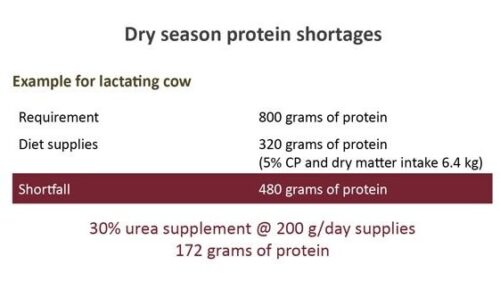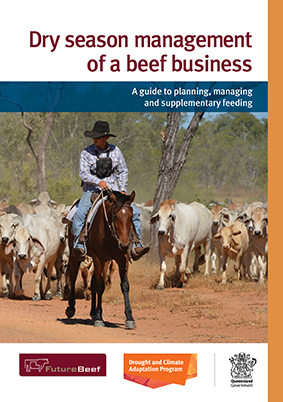Planning and managing a supplement feeding program
To carry out a cost-effective supplement feeding program there are five key things to determine first:
- What level of performance is required from the targeted group? Is it:
a. maintenance or
b. production, and what level of production (e.g. 0.2kg per day or 0.5kg per day)? - What will be the nutritional requirements to achieve desired performance? Nutritional requirements will depend on the level of performance required (maintenance or production). It is essential to determine what nutrients are going to limit animals reaching the desired performance target. For more information see Nutrient requirements of beef cattle.
- What level of nutrients is the pasture supplying? The most accurate way to assess the diet quality the pasture is supplying is to use a tool called NIRS. NIRS estimates the diet quality of grazing cattle in terms of protein and energy. For more information see Assessing pasture diet quality (NIRS).
- What is the level of nutrition required to correct the nutrient shortfall? This is the difference between what cattle need (requirements) to meet desired level of performance and what the pasture is supplying. It is important to firstly supply the nutrient that is most limiting, generally the limiting nutrient is what the cattle will be most deficient in. This could be protein, energy, phosphorus or other minerals and vitamins.
- How cost-effective is the supplement given expected cattle performance. For more information see Costing supplements.
What nutrients limit cattle performance?
Cost-effective supplementation programs address the primary limiting nutrient first. Animal performance will be limited by the availability of the most limiting nutrient, and supply of other nutrients will have no effect until this is corrected.
Dry season
- Protein
- Energy
- Phosphorus (acutely deficient land types only)
-
-
In the dry season generally the primary limiting nutrients are firstly protein, then energy, then phosphorus. Protein levels in pasture drop off as the dry season progresses, hence protein becomes limiting first.
Energy becomes limiting when there isn’t enough feed or the feed is of very low quality. When the feed is of low quality it becomes indigestible and provides low amounts of energy in the diet. Compounding this is the resulting low intakes of pasture. So not only is diet quantity important (i.e. amount of feed) but so is diet quality.
Phosphorus may be the limiting nutrient in acutely deficient country as demand for phosphorus will be higher particularly during lactation and growth.
Wet season
- Phosphorus
- Salt and sulphur (basalt only)
On phosphorus deficient country during the wet season phosphorus becomes the primary limiting nutrient and responses to phosphorus supplementation will be greater during the growing season.
On certain areas of ‘basalt’ country, phosphorus will be adequate but levels of salt and sulphur may limit production.
Protein
Mature, dry pasture is usually low in protein. This results in reduced activity of rumen microbes prolonging digestion and reducing intake of pasture. Providing a small amount of protein (150g per day for dry pregnant breeders, or 75g per day for weaners) may reduce weight loss, and in the very early dry season may allow dry stock to make slight weight gains. For more information see Protein and urea supplementation.
Correcting protein deficiencies for lactating cows in the dry season is much more difficult as shown by the example below. Urea dry licks may not be able to supply enough protein to correct the shortfall in protein needed, due to the high requirements of lactation. For more information see Nutritional management of breeders.

Energy and protein
If growth above about 0.2kg/head/day is desired from pasture of low quality, energy and protein will both be limiting production. Energy as well as protein will also be required in the late dry season if animals are to maintain weight on pasture that has been dry for three to four months and has lost most of its leaf. For more information see Energy supplementation.
Phosphorus
Phosphorus is the mineral most commonly deficient in grazing cattle however it is only required when animals are producing (i.e. growing or lactating). Therefore the demand for phosphorus in winter (dry season), when animals are not growing, is very low. The exception is grossly deficient land types where a higher production level is required for lactation and/or growth. For more information see: Phosphorus supplementation of cattle in northern Australia.
Sulphur
Sulphur and nitrogen are required by the rumen microorganisms to form microbial protein. Most supplements contain sufficient sulphur to meet the needs of the microbes. However, when urea (nitrogen) is fed in a dry mix with salt there is insufficient sulphur for the microbes. To overcome this deficiency feed 1kg Gran-am to 5kg urea or 1kg elemental sulphur to 20kg urea. These feeding rates are calculated to feed 10 units of nitrogen to 1 unit of sulphur. For more information see Minerals and vitamins.
Selecting a supplement
Once the nutrients that are limiting production are determined a supplement can be selected to meet these requirements. To do this it may be best to categorise supplements into the nutrients they provide as follows:

To meet nutrient requirements it may be necessary and more cost effective to combine some supplements such as urea and molasses to get both protein and energy. For more information see Nutrient composition of feeds.
Once supplements have been grouped then a selection can be made considering:
- cost
- availability
- palatability
- ease of feeding
- preparation required
- equipment (and skill required to feed).
If feeding a protein supplement it may be useful to compare the cost of that supplement with the cost of a supplement that gives both energy and protein. Sometimes a supplement that provides protein and energy is the same cost as a protein supplement. This would mean performance could be above the target for the same cost. For more information see Costing supplements.
There are calculation tools available to assist you with making these decisions:
- Beef Business Tools – FutureBeef
- Feed cost calculator – Western Australia Department of Primary Industries and Regional Development
- Costs and nutritive value calculator – NSW Department of Primary Industries
- Drought and supplementary feed calculator – NSW Department of Primary Industries
- Drought feed calculator app – NSW Department of Primary Industries.
Further information
- Nutrient requirements
- Nutrient composition of feeds
- Protein and urea
- Energy supplements, including molasses supplementation
- Minerals and vitamins, including phosphorus
- Nutritional management of breeders
- Compensatory growth
- Product labels – what are they saying?
- Costing supplements.
Additional resources
Dry season management of a beef business (booklet)
Russ Tyler and Felicity Hamlyn-Hill, formerly Queensland Government.
Reviewed by Caitlyn Frazer and Jed Sommerfield, Department of Agriculture and Fisheries
This document was reviewed as part of the GrazingFutures Project. GrazingFutures is funded by the Queensland Government’s Drought and Climate Adaptation Program (DCAP) that aims to build drought and business resilience for Queensland livestock producers.